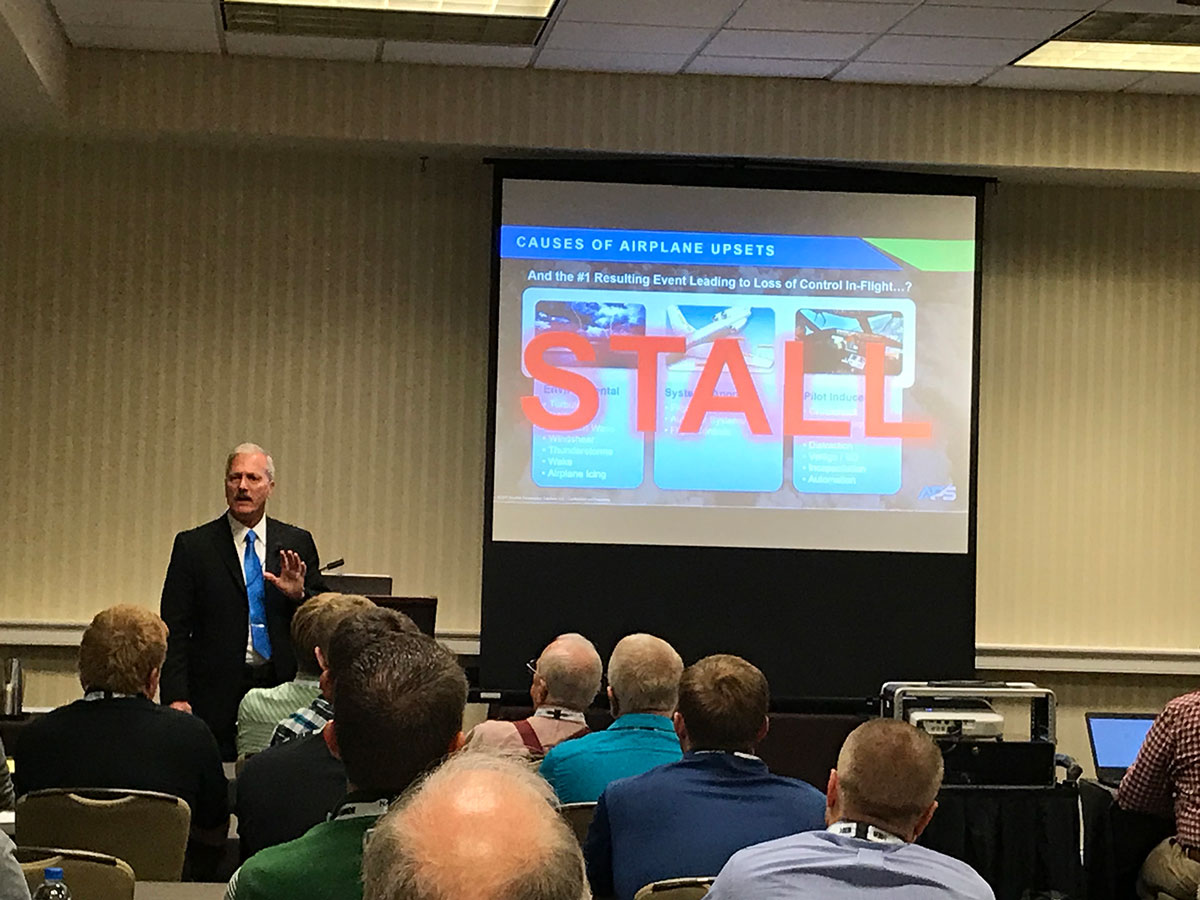 SUMMARY: “The Normalization of Excellence” provided the theme and framework for talks and presentations at the 2018 Bombardier Safety Standdown. The topic of Upset Prevention and Recovery Training (UPRT) exemplifies this standard of excellence not only through preparing pilots to prevent or overcome aviation’s most lethal safety threat, Loss of Control In-flight (LOC-I), but also by honing and refining pilots’ manual handling and airmanship skills, making them more excellent pilots all around. The following summarizes APS VP Randy Brooks’ 2018 Safety Standdown presentation on “The Aerodynamics of UPRT.”
SUMMARY: “The Normalization of Excellence” provided the theme and framework for talks and presentations at the 2018 Bombardier Safety Standdown. The topic of Upset Prevention and Recovery Training (UPRT) exemplifies this standard of excellence not only through preparing pilots to prevent or overcome aviation’s most lethal safety threat, Loss of Control In-flight (LOC-I), but also by honing and refining pilots’ manual handling and airmanship skills, making them more excellent pilots all around. The following summarizes APS VP Randy Brooks’ 2018 Safety Standdown presentation on “The Aerodynamics of UPRT.”
Read about APS UPRT Programs
The Bombardier Safety Standdown: A Tradition of Excellence
Last week APS Vice President of Training and Business Development Randy Brooks had the opportunity to speak at the Bombardier Safety Standdown conference, held October 30 – November 1, 2018 at the Hyatt Regency hotel in Wichita, Kansas. Open to all aviation professionals, regardless of operator or aircraft type, Safety Standdown began in Wichita in 1996 as an aviation safety training event for a Bombardier Learjet Flight Demonstration Team. In 1999, in response to growing interest within the industry, Bombardier opened the seminar to all pilots, and in 2010, Safety Standdown expanded beyond the seminars into a year-round global human factors program offering online and social media resources.
The theme of the 2018 conference was “The Normalization of Excellence,” which centered on going above and beyond regulatory minimums and aspiring for excellence in every sphere of flight operations and training. The theme is in keeping with the excellent standard of safety set by the conference, and it serves as a good reminder for all of us in aviation to set our sights high and never compromise where safety is concerned.
Excellence in UPRT: Why Is it so Important?
Randy’s presentation on the Aerodynamics of “Upset Prevention and Recovery Training” concentrated on the aerodynamic differences seen in the upset domain which are unfamiliar to those whose only flight experience comes from within the normal envelope or from flight simulation, which has significant technical and human factors limitations outside of the normal flight envelope.
Aircraft behavior and stall characteristics beyond the critical angle of attack are markedly different than what pilots experience in the typical stall training received during licensing training. While aircraft upsets are artificially segregated by training regulations into two separate training tasks encompassing “unusual” attitudes and approaches to stalls, in the real world pilots may face both circumstances at the same time. Lateral instability beyond the stall is likely to lead to severe attitudes, and inappropriate or over aggressive recoveries from extreme attitudes can easily lead to an accelerated stall.
When encountered simultaneously, these combined conditions often require pilots to rapidly assess and respond to situations with a complexity well beyond beyond anything seen in required by current training regulations. The result is that Loss of Control In-flight (LOC-I) is the leading cause of fatalities in every sector of aviation according to the National Transportation Safety Board, the International Civil Aviation Organization, and the International Air Transport Association.
The fidelity and human factors limitations of flight simulators in the airplane upset domain were also addressed. Technical limitations in the full range of angle of attack and sideslip used to program simulators along with human factors differences between the virtual and real world create a more benign and simplified recovery challenge in a simulator than what pilots are faced with in actual flight. Unfamiliarity with aerodynamics encountered outside of the normal envelope combined with natural pilot responses based on what they see and experience in standard flight operations can lead to inappropriate or even catastrophic pilot inputs to unexpected upset events.
Randy made the point that, “Excellence in the upset domain demands our knowledge and skill not only in normal operations, but in the understanding of aerodynamics required to prevent departing the normal envelope and the skill required to safely and effectively return to it. It is difficult to develop the necessary knowledge and expertise in recovering to the normal envelope without ever leaving it.”
2018 Safety Standdown Award
Special acknowledgement is due to this year’s Safety Standdown Award Winner, Martin G. Grier; the Senior Manager for Aircraft Maintenance of the The Home Depot aviation department in Atlanta Georgia. Mr. Grier was the first aircraft maintenance professional to be awarded this prestigious award, which illustrates how we must all work together for excellence and safety in aviation.




Comments: